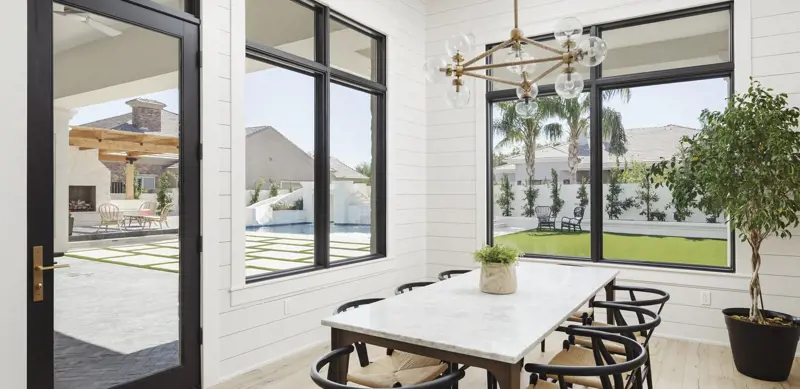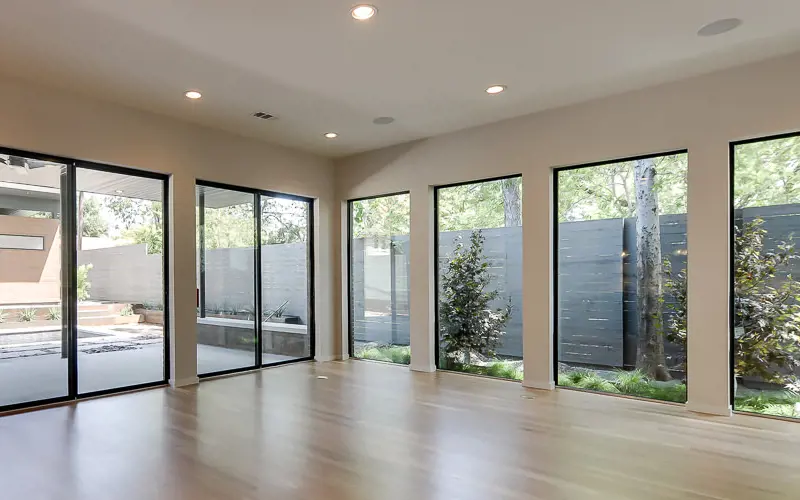
What is Dissimilar Glass?
Dissimilar glass and other sound-reducing window options
Replacing old windows with new ones can make a huge difference in the look and feel of your home. We always talk about how windows protect your home from outside elements like water and wind and how replacement windows can reduce your energy costs, but today let’s talk about how your windows can also help reduce the amount of noise entering your home from outdoors.
Noise enters your home through its envelope. The envelope includes exterior walls, windows, doors, and the roof. Each element works together to protect your home and keep you comfortable, they also insulate your home from sound transmission. Windows with good Sound Transmission Class (STC) ratings can help combat the sounds of trains, traffic, airplanes, and people in conversation.
Keep reading for a more thorough understanding of sound transmission and windows or use this link to skip ahead to the “Windows with dissimilar glass” section.

What is an STC-rating?
STC-ratings measure the extent to which a material can reduce sound waves. The higher the rating, the better the material is at blocking sound transmission. The STC system is the most widely recognized method for comparing the acoustic performance of building products, but it’s not the only method.
The Outdoor/Indoor Transmission Class (OITC) system is also used. This system specifically measures the extent to which low-to-mid frequency noises (heavy traffic, airplanes, trains, etc.) are blocked. Both rating systems offer a good idea of acoustic performance.
What is a good STC rating for windows?
To understand what a “good” rating is, we must first have a metric to compare it to. A typical exterior wall with 2x4 timber and insulation has an STC rating estimated between 34-39 (↗) while other wall assemblies can have STC ratings well into the 50s and 60s. For the average home, it typically doesn’t make sense to purchase windows with a higher STC rating than the walls because the noise will transmit through the walls rather than the windows.
STC ratings for windows typically range from 18-38.
|
STC-RATING BY WINDOW TYPE |
|
Existing Single-Pane Windows |
|
Dual-Pane Windows w/standard glass |
|
Dual-Pane Windows w/Dissimilar glass |
What type of windows do we recommend for sound reduction?
Windows with dissimilar glass.
When sound transmission is a major concern for homeowners we recommend windows with dissimilar glass. Window units with dissimilar glass packages are the most cost-effective solution when sound transmission is the primary concern.
Some companies tout triple-pane glass units and laminated glass units as the ideal solution for sound reduction but considering cost and energy requirements, these aren’t practical solutions.
What is dissimilar glass?
Windows with dissimilar glass are similar to a standard double pane window except they consist of two panes of glass with different thicknesses. A standard double pane window glass unit consists of two panes of glass that are the same thickness.
For example, one pane of glass may be ⅛” thick while the other is a ¼” thick. Each pane that is a different thickness blocks different frequencies resulting in a window unit that reduces sound transmission over a greater range of frequencies when compared to a standard window unit. By blocking different frequencies, the dissimilar glass is breaking up the sound waves which is key to reducing sound transmission through the window unit.
How does dissimilar glass compare to triple-pane windows or windows with laminated glass?
Let’s start with triple pane windows.

Triple-pane windows are a good energy-efficient choice for homes in cold climates because of their ability to resist cold air below 20º. The additional pane of glass means there is less space between each pane which actually makes it perfect for use with Krypton gas. Krypton and Argon gas (used in double-pane) both act as barriers against cold air but Krypton gas is denser. For those of us in warmer climates, double-pane windows are a more sensible and energy-efficient choice.
As far as sound reduction goes, triple-pane windows don’t really provide any more sound reduction than a standard double-pane window.
In fact, some triple-pane windows may even perform worse than double-pane windows because they have smaller air chambers between the panes of glass. For sound reduction, more panes of glass in the window unit can be counterproductive. This is because less space can cause more reverberation in the soundwaves resulting in amplified sound.
LEARN MORE: Triple Pane Windows
What about windows with laminated glass?

Laminated glass in windows is composed of two sheets of glass with a layer of polyvinyl butyral (PVB) film in between. Laminated glass in windows is considered a safety feature because it is more difficult to break and when broken, the shards of glass are held together by the PVB film making it less likely to cause injury than standard glass.
The layer of PVB film also helps dampen soundwaves, it does such a good job that it typically has a slightly better STC-rating than dissimilar glass. The difference isn’t substantial enough for us to recommend laminated glass over dissimilar glass for sound reduction purposes alone.
Laminated glass has many benefits but if sound reduction is the only concern, we still recommend dissimilar glass because it produces similar results for a much lower cost.
Why is dissimilar glass the best option for sound reduction?
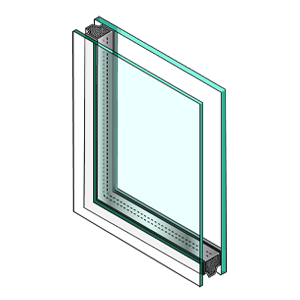
The combination of glass thicknesses and wide air space result in windows that are better at reducing sound transmission.
Each pane blocks different sound frequencies which means a greater range of sounds are being prevented from transmitting through the glass. Wide air space is key in improving STC rating because it reduces the transfer of vibrational energy from one layer of glass to another (mass-air-mass resonance).
Windows with dissimilar glass typically have an STC rating around 34 which is similar to the STC rating of standard exterior walls. Securing a higher STC rating than this is possible but impractical because it is more expensive and sound can enter through lower-performing parts of the home such as the exterior walls.
- Compared to single-pane windows
Double-pane windows with dissimilar glass are able to block a wider range of sound frequencies (as well as provide additional energy efficiency benefits). The same can be said for regular double-pane windows. - Compared to triple-pane windows
Windows with dissimilar glass block a wider range of sound frequencies and they typically have more air space between each pane. More air space typically means less resonance frequency and improved insulation against noise. - Compared to windows with laminated glass
Double-pane windows with dissimilar glass have a slightly lower STC rating. From our perspective, dissimilar glass provides similar results for a lower cost making it a better option for most homeowners.
When comparing STC ratings consider these benchmarks offered by Jeld-Wen(↗):
- 2-point STC improvement is not perceptible
- 4-point STC improvement is clearly perceptible
- 10-point STC improvement reduces sound by about 50%
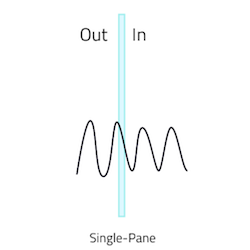

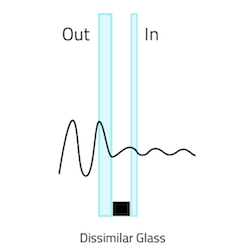
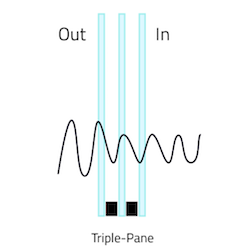
Who sells dissimilar glass windows?
Many manufacturers offer dissimilar glass including Andersen and Jeld-Wen.
You should also know:
The type of material and window style also affect how much noise your window unit will transmit.
For example, fixed windows are completely sealed, so noise can’t pass through them as easily as windows with operable sashes. Awning and casement windows typically have tighter seals than hung windows so these styles should block more sound as well.
![]()
![]()
![]()
Once you do more research you’ll see there are lots of options for reducing sound transmission.
If your windows are ready to be replaced, you can feel confident that with today’s technology you’ll be able to customize a window to meet your needs. The best way to get the perfect windows is to work with a remodeling company that can help you order custom windows directly from the manufacturers.
One last thing to remember is that in order to get the most benefit from your STC- and ENERGYSTAR®- rated windows, they should be ordered and installed by experienced professionals. Ordering the right size windows for existing openings and having them installed properly is crucial to the success of the remodeling project.
A high-quality window will only outperform a lower-quality window when it’s installed properly, and a window installed improperly will never achieve its desired performance.
Make sure you connect with a company or contractor that you can trust to get the job done right.
North Texas homeowners who are ready to replace their windows can call us at 817-860-9767 to schedule a free in-home consultation or you can also submit this form to have one of our office representatives contact you.
Oops!
We don't currently serve your area but do want to help you plan your project. Try our Build & Price tool to get an idea of window & door costs within DFW. Your area may be higher or lower but at least you'll have some idea of the price.
Thanks for stopping by.




